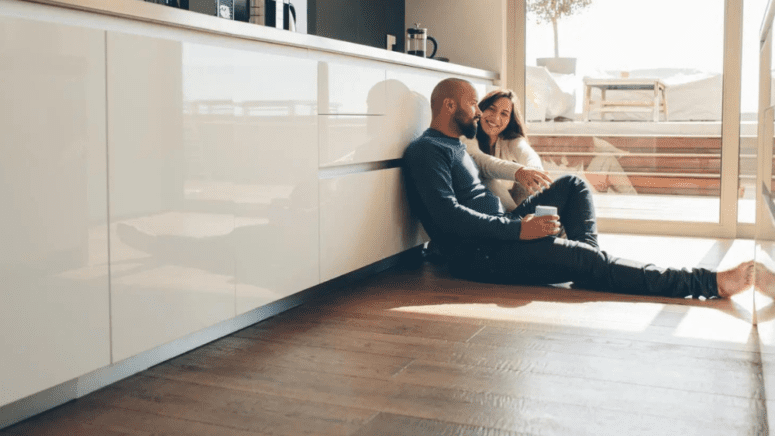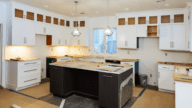Does New Flooring Increase Home Value? 5 Pro Tips to Get the Most Money Back When You Sell
- Published on
- 5 min read
-
 Valerie Kalfrin, Contributing AuthorClose
Valerie Kalfrin, Contributing AuthorClose Valerie Kalfrin Contributing Author
Valerie Kalfrin Contributing AuthorValerie Kalfrin is a multiple award-winning journalist, film and fiction fan, and creative storyteller with a knack for detailed, engaging stories.
-
 Richard Haddad, Executive EditorClose
Richard Haddad, Executive EditorClose Richard Haddad Executive Editor
Richard Haddad Executive EditorRichard Haddad is the executive editor of HomeLight.com. He works with an experienced content team that oversees the company’s blog featuring in-depth articles about the home buying and selling process, homeownership news, home care and design tips, and related real estate trends. Previously, he served as an editor and content producer for World Company, Gannett, and Western News & Info, where he also served as news director and director of internet operations.
Home flooring takes a beating every day while tasked with a monumental responsibility: Setting the design tone for your entire house. Your Pottery Barn catalog doesn’t capture the pet hair settled deep in your living room carpet or the scratches and scuffs on your wood floors.
Buyers who tour your home definitely have those magazine-worthy floors in mind. They want to see flooring that’s not only in great condition but also fits each room’s purpose and looks like a million bucks.
Leighann Nash, a real estate agent in Atlanta, views flooring as a relatively inexpensive upgrade that yields a strong return on investment (ROI). She notes that spending a few thousand dollars to replace worn-out carpet — particularly if you have pets — can greatly enhance your home’s value.
We’ve done the legwork on which flooring options offer the best ROI and identified the latest design trends (hint: hardwood remains king).
So, does new flooring increase home value? The answer is yes — if you choose wisely. The right flooring upgrades not only boost your home’s value but can also help it sell faster. Follow these 5 pro tips to make the most of your flooring investment.
1. Invest in hardwood flooring for maximum ROI
Hardwood floors are a classic choice that continues to impress buyers. Historically, hardwood flooring has been a staple in American homes, evolving from simple planks to intricate designs. Today, it’s still very highly valued.
According to a recent survey by Frontdoor.com, listings for homes with hardwood floors on Zillow receive an impressive 261 views daily. This feature is so desirable that 54% of buyers are willing to pay a premium for it, and 64% of homeowners who install hardwood floors themselves find that it enhances their enjoyment of their home.
Even Martha Stewart reports that hardwood flooring tops the list of most desirable home features that buyers are looking for.
Hardwood floors are both timeless and durable. Unlike carpet, which typically needs replacing every decade, hardwood can last much longer with proper care. Regular recoating every three to five years and refinishing every 8 to 10 years help maintain their longevity and versatility.
Hardwood flooring cost overview
The cost of installing hardwood floors can vary significantly depending on various factors. On average, you can expect to pay between $2,478 and $7,030 for hardwood flooring installation, with a typical cost of about $4,726, according to HomeAdvisor. This range accounts for both materials and labor, and the final price will depend on the type of hardwood, the size of the area, and any additional work required, such as subfloor preparation or removal of old flooring.
Prices can fluctuate based on your location and the complexity of the installation. For the most accurate estimate tailored to your specific needs, it’s a good idea to obtain quotes from local contractors. HomeAdvisor provides a Hardwood Flooring Cost Calculator that allows you to enter your ZIP code and get a customized pricing estimate based on your area and project details. This tool can help you better understand the potential costs and plan your budget accordingly.
How do types of hardwood vary in cost?
Even among wood floors, there are different cuts, degrees of thickness, and wood types that affect price. Some examples:
- Stained Red Oak: This popular choice costs between $8 and $13 per square foot.
- Black Cherry: Known for its natural cinnamon hue that deepens over time, it ranges from $4.30 to $30 per square foot.
- Rusty-Hued Heart Pine: A classic for Southern homes, it falls between $4.50 and $13 per square foot.
- White Ash: Sturdier and lighter in color, white ash is priced around $9 to $11 per square foot.
2. Explore budget-friendly alternatives
If you’re looking for a more budget-friendly option, consider alternatives that mimic the look of hardwood:
- Vinyl Flooring: Versatile and affordable, vinyl comes in various designs, including faux wood and tile. It’s durable but less so than real wood, but with proper care, it can last for 20 years. Vinyl sheets cost $0.50 to $41per square foot, while planks and tiles cost about $5 per square foot. Homeowners typically can install those themselves.
- Linoleum: This eco-friendly long-wearing choice costs $2 to $2.50 per square foot for sheets, $3.50 to $5 per square foot for tiles, and $7 to $9 for click-together options. It’s renewable, recyclable, and requires resealing every five years. Installing linoleum flooring costs $1,760 on average, depending on the square footage. Most spend between $650 and $4,800, or $3 to $12 per square foot.
- Choose hardwood with character. Hardwood flooring comes in various “grades,” reflecting its natural imperfections and unique features. For a more affordable option, consider oak with noticeable color variations, knots, and streaks. “Rustic” or “utility” grade wood offers these distinctive features at a lower cost. Alternatively, stained and sealed 2×4-foot plywood planks can provide a rustic appearance for about $5 per square foot.
- Install carpet tiles: For a flooring refresh, consider carpet tiles priced from $2.50 to $11 per square foot in various colors and patterns. Traditional carpet, also known as “broadloom” carpet, is more affordable upfront, ranging from $1 to $8 per square foot.
- Paint your floors. Specialized paint can revitalize wood, cement, tile, or linoleum surfaces, and preparation products ensure a smooth finish. Paint and polyurethane will only set you back around $0.50 to $1 per square foot.
Exploring these cost-effective flooring alternatives can help you achieve the look you desire while staying within budget. Beyond just aesthetics, investing in quality flooring can increase your home value and provide a solid ROI. Whether you choose vinyl, linoleum, carpet tiles, or even a fresh coat of paint, these options offer practical ways to enhance your living space without compromising on style or long-term value.
3. Choose flooring based on room use
Flooring should be chosen based on the room’s function and traffic. For high-traffic areas like kitchens and entryways, durable materials such as ceramic tile or hardwoods like oak or hickory are ideal. Avoid solid wood in basements or bathrooms due to humidity issues — opt for engineered wood instead.
The flooring’s foundation also will influence your budget and flooring choice. For instance, if you rip out carpeting to find concrete or tile underneath, your new flooring needs to be a click-together floating option or flooring that can be glued down — nothing that requires nails.
4. Select timeless, wide-appeal colors
Nash has seen that buyers are all about tile in the bathrooms and hardwood in the main living areas.
For hardwood floors, some color palettes and textures popular in 2024 include deep, rich hues like charcoal and navy, which add a sophisticated touch to modern interiors. Warm tones such as honey and chestnut are also trending, providing a cozy, inviting feel. Lighter, natural hues like sandy beige and soft oak continue to be favored for their fresh and airy appeal. Additionally, sustainable flooring options and nature-inspired colors, such as reclaimed wood and earthy greens, are gaining traction. Mixed-width planks and hand-scraped finishes are also popular, adding depth and character to floors. These choices reflect a blend of elegance and environmental consciousness, catering to contemporary tastes while ensuring timeless appeal.
When choosing flooring, go for colors and finishes that have broad appeal. Popular trends include:
- Charcoal black: Offers a matte, sophisticated look.
- Rich brown: Provides a warm and luxurious feel, especially in walnut.
- Stone gray: Versatile and works well with various design styles.
- Off-white and matte finishes: Create a clean and modern look.
Avoid overly dark shades that show dust and footprints. Opt for colors that will enhance your home’s aesthetic and attract a wide range of buyers.
5. Ensure a seamless flooring flow
When updating your flooring, consistency is key. You want to ensure a smooth transition between rooms without mismatched colors or finishes. This is where professional flooring installers come in handy — they can sand and refinish surfaces to create a seamless look that blends with your existing floors.
A carefully planned flooring upgrade doesn’t just boost your home’s value and ROI; it also enhances the overall flow and aesthetic of your space, making it more appealing and cohesive.
“You definitely don’t want to walk into the foyer that’s a cherry color, and then your dining room and your living room off to the left and the right are three shades lighter,” Nash said. “You want to match it to what you already have as best as you can so that you get that flow feeling when the buyer first walks in the door.”
Flooring as Your Home’s Foundation
These 5 pro tips will help you boost ROI and increase your home’s value. As interior designer Emily Morrow Finkell puts it, “Home interior design begins with the floor. The floor is your blank canvas and it determines every design decision you’ll make once it’s down.”
Even if buyers aren’t design experts, your flooring will be one of the first things they notice and comment on. Choose your materials based on durability and style, and it will be an investment you won’t regret.
- "The Home Features Americans Are Most Interested In," Frontdoor (December 2023)
- "New Report Reveals the Features Home Buyers Want Most, From Hardwood Floors to Sunken Tubs," Martha Stewart, Madeline Buiano (January 2024)
- "How Long Does Carpet Last? 7 Signs You Need to Replace It," Angi, Lauren Hamer (December 2023)
- "How Long Do Hardwood Floors Last? Maintenance Makes a Big Difference," Angi, Lauren Bongard (September 2023)
- "How Much Does It Cost To Install Hardwood Floors?," HomeAdvisor (January 2024)
- "A Complete Guide to Hardwood Flooring," This Old House (August 2024)
- "Linoleum Vs. Vinyl Flooring: Major Differences, Pros, Cons And Costs," Forbes, Barbara Zito (July 2023)
- "Carpet Tiles vs. Carpet: Which One Will Floor You?," Angi, Jamie Cattanach (April 2024)
- "Hardwood Vs. Engineered Wood Flooring: Major Differences, Pros And Cons," Forbes, Geraldine Orentas & Lexie Pelchen (March 2024)
- "8 Flooring Trends Pros Say Will Be Huge in 2024," The Spruce, Cori Sears (December 2023)
- "8 Modern Flooring Trends for 2024: What’s In and What’s Out," Hamernick's (April 2024)


